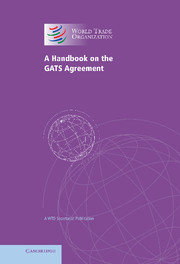Book contents
- Frontmatter
- Contents
- Preface
- Introduction
- 1 Basic purpose and concepts
- 2 Main building blocks: agreement, annexes and schedules
- 3 A closer look at domestic regulation
- 4 How the GATS is administered
- 5 The role and responsibilities of Member governments
- 6 The challenges ahead
- 7 Preparing requests and offers
- 8 Misconceptions about the GATS
- Appendix 1 Understanding your country's services trade
- Appendix 2 Relevant services statistics and classifications
- Annex: General Agreement on Trade in Services
- Index
1 - Basic purpose and concepts
Published online by Cambridge University Press: 07 October 2011
- Frontmatter
- Contents
- Preface
- Introduction
- 1 Basic purpose and concepts
- 2 Main building blocks: agreement, annexes and schedules
- 3 A closer look at domestic regulation
- 4 How the GATS is administered
- 5 The role and responsibilities of Member governments
- 6 The challenges ahead
- 7 Preparing requests and offers
- 8 Misconceptions about the GATS
- Appendix 1 Understanding your country's services trade
- Appendix 2 Relevant services statistics and classifications
- Annex: General Agreement on Trade in Services
- Index
Summary
HISTORICAL BACKGROUND
The General Agreement on Trade in Services (GATS) is the first multilateral trade agreement to cover trade in services. Its creation was one of the major achievements of the Uruguay Round of trade negotiations held from 1986 to 1993. This was almost half a century after the entry into force of the General Agreement on Tariffs and Trade (GATT) of 1947, the GATS counterpart in merchandise trade.
The need for a trade agreement in services has long been questioned. Large segments of the services economy, from hotels and restaurants to personal services, have traditionally been considered as domestic activities that do not lend themselves to the application of trade policy concepts and instruments. Other sectors, from rail transport to telecommunications, have been viewed as classical domains of government ownership and control, given their infrastructural importance and the perceived existence, in some cases, of natural monopoly situations. A third important group of sectors, including health, education and basic insurance services, are considered in many countries to be governmental responsibilities, given their importance for social integration and regional cohesion, which should be tightly regulated and not be left to the rough and tumble of markets.
Nevertheless, some services sectors, in particular international finance and maritime transport, have been largely open for centuries – as the natural complements to merchandise trade. Other large sectors have undergone fundamental technical and regulatory changes in recent decades, opening them to private commercial participation and reducing, even eliminating, existing barriers to entry.
- Type
- Chapter
- Information
- A Handbook on the GATS AgreementA WTO Secretariat Publication, pp. 2 - 9Publisher: Cambridge University PressPrint publication year: 2005

